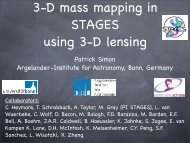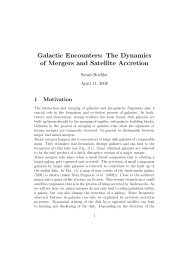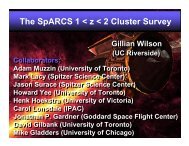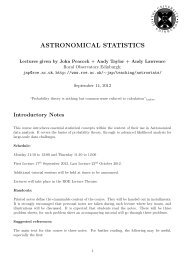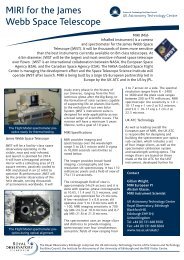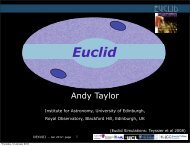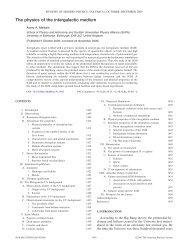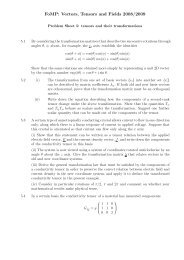Physical Characterisation of the Binary EKBO 2001 QT297
Physical Characterisation of the Binary EKBO 2001 QT297
Physical Characterisation of the Binary EKBO 2001 QT297
Create successful ePaper yourself
Turn your PDF publications into a flip-book with our unique Google optimized e-Paper software.
Draft<br />
Figure 1: Discovery observation <strong>of</strong> <strong>the</strong> binarity <strong>of</strong> <strong>2001</strong> QT_297. This single 300 second exposure was<br />
obtained with MagIC at <strong>the</strong> Magellan Project Baade 6.5m telescope on UT 11 October <strong>2001</strong> using a Sloan r’<br />
filter under exceptional seeing <strong>of</strong> 0.31 arc seconds.<br />
2. Observations and Analysis<br />
The discovery and all subsequent follow-up observations for this program were carried out with<br />
<strong>the</strong> Raymond and Beverley Sackler Magellan Instant Camera (MagIC) at <strong>the</strong> Magellan Project<br />
Baade and Clay 6.5m telescopes. MagIC is a highly efficient cryo-cooled CCD camera system<br />
utilizing a SITe 424a (2k x 2k) detector and equipped with a filter compliment including BVRI,<br />
and Sloan u’,g’,r’,i’,z’. Deployed at <strong>the</strong> f/11 focus <strong>of</strong> <strong>the</strong> Baade and Clay 6.5m telescopes,<br />
MagIC’s field <strong>of</strong> view is 140 arc seconds on a side with a pixel scale <strong>of</strong> 0.069 arc seconds/pixel.<br />
Following <strong>the</strong> discovery and confirmation observations on UT 11-12 October <strong>2001</strong>, we have<br />
carried out 5 additional successful observing runs to investigate color and variability <strong>of</strong> <strong>the</strong> binary<br />
components and to establish an initial orbit fit to <strong>the</strong> high accuracy astrometry that we have<br />
obtained. Initial follow-up was carried out at <strong>the</strong> Baade telescope on UT 1-4 November <strong>2001</strong><br />
using fractional nights during a previously scheduled instrument engineering run. The next<br />
successful observations were not until UT 13 July 2002, when time series photometry and color<br />
measurements were obtained (using <strong>the</strong> Sloan g’,r’,i’ filters). An additional 7 hours <strong>of</strong> temporal<br />
monitoring was obtained (using Sloan r’ and i’ filters) on UT 18 July 2002. Following <strong>the</strong><br />
successful July runs, astrometric observations were added on UT 7 August 2002 and 8 September<br />
2002. <strong>Binary</strong> component separations and position angles are calculated from all <strong>the</strong> Sloan r’<br />
measurements for each night. These values are provided in Table 1 along with <strong>the</strong> measured time<br />
series differential photometry for <strong>the</strong> two binary components.<br />
All frames were processed with standard overscan subtraction and flat fielding (using a<br />
combination <strong>of</strong> twilight and dome flats). For each night, <strong>the</strong> binary pair and a group <strong>of</strong> stellar<br />
comparisons were identified in each frame and standard circular aperture photometry was carried<br />
out to determine object centers, peak signal levels, and background levels. These parameters<br />
were <strong>the</strong>n used as input for point spread function (PSF) modeling (Elliot et al. 1989; Bosh et al.<br />
1993;Elliot et al. 2003). A roughly 2x2 arc second sub-array was selected from <strong>the</strong> calibrated<br />
image for each object, and an analytic PSF (in our case, ei<strong>the</strong>r a circular Lorentzian or a circular



